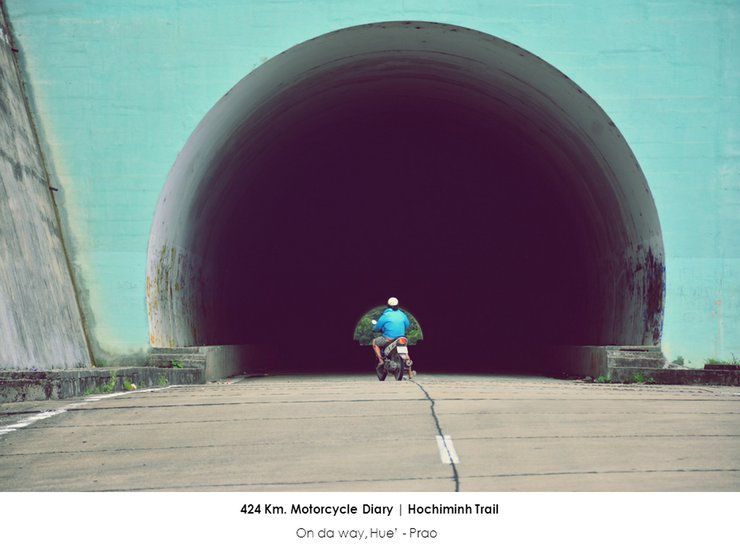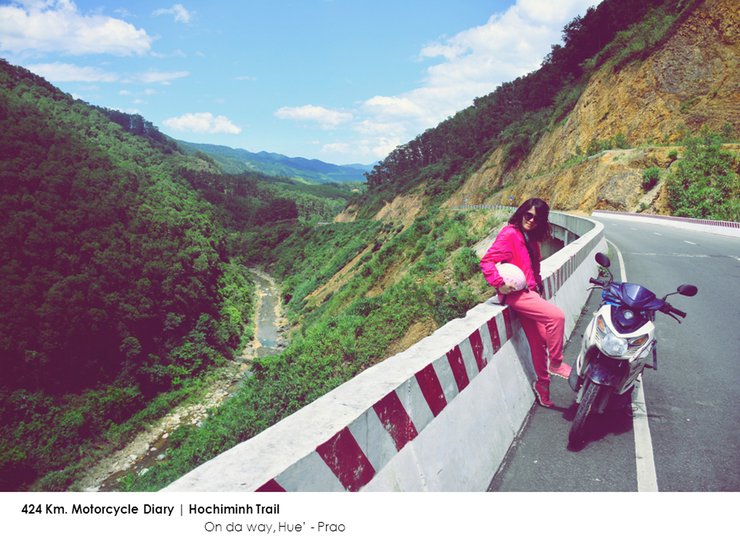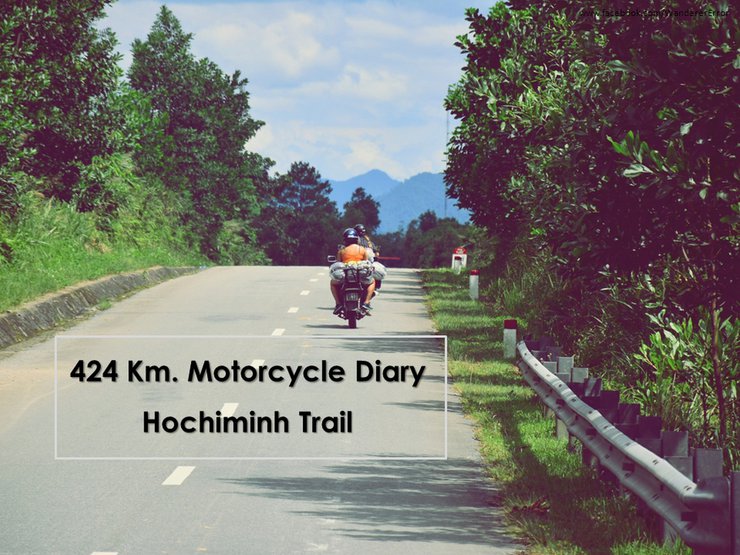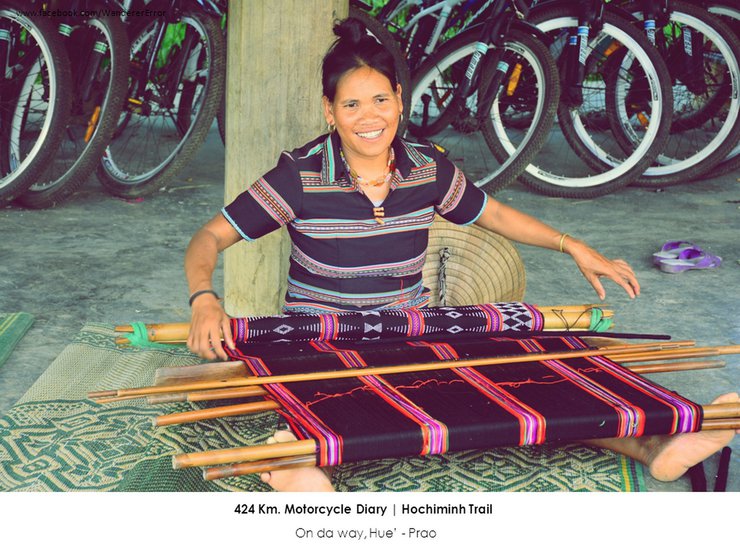
This review is a spin-off of the 5th story in "Hue' May I hug you!! | 5 small stories that I want to hug you with all my might".
https://th.readme.me/p/5626
We wanted to provide more details about the journey and atmosphere along this route. The path offers diverse views and landscapes, as well as various tourist attractions to explore along the way. We have therefore written a separate section for those who may be interested.
The Ho Chi Minh Trail: A Vital Lifeline During the Vietnam War
The Ho Chi Minh Trail, named after Vietnamese revolutionary leader Ho Chi Minh, played a crucial role in the Vietnam War. This network of paths and roads stretched from North Vietnam through Laos and Cambodia, providing a vital supply route for the North Vietnamese Army (NVA) and the Viet Cong.
The trail's strategic importance stemmed from its ability to circumvent the heavily fortified Demilitarized Zone (DMZ) separating North and South Vietnam. By traversing the mountainous terrain of Laos and Cambodia, the NVA could transport troops, weapons, and supplies directly into South Vietnam, bypassing American defenses.
The Ho Chi Minh Trail was a complex and extensive network, spanning over 1,000 kilometers and encompassing a variety of paths, roads, and waterways. Its winding routes often followed mountain ridges and river valleys, making it difficult for American forces to detect and disrupt. The trail was also constantly evolving, with new routes being created and existing ones being improved.
Despite its importance, the Ho Chi Minh Trail was a dangerous and challenging route. The terrain was rugged and unforgiving, and the NVA faced constant threats from American bombing and ambushes. However, the trail's strategic value outweighed the risks, and it remained a vital lifeline for the North Vietnamese throughout the war.
The road is currently maintained and named after Uncle Ho in his honor.

The Ho Chi Minh Trail: A Classic Motorcycle Journey
The Ho Chi Minh Trail, a historic route stretching over 1,000 kilometers from Hanoi to Ho Chi Minh City, has become a popular destination for adventurous motorcyclists, particularly international travelers. While traversing the entire trail can take over a week, shorter segments offer a taste of this iconic path.
According to numerous foreign tourists who have reviewed the Ho Chi Minh Trail on Tripadvisor, the most scenic stretch of road is between Hue and Prao. This section is shorter than the full route and offers breathtaking views, making it a popular choice among travelers.
Initially, we planned to take a bus to Hoi An. However, we saw many signs offering one-way motorbike rentals from Hue to Hoi An, which piqued our interest. This option allowed us to return the motorbike in Hoi An.
Upon further research, I stumbled upon this route, sparking a desire to follow in the footsteps of Uncle Ho, à la Che Guevara in Motorcycle Diaries. Thus began our impromptu motorcycle adventure.


Day 1:
We departed from Hue at 10:00 AM, dividing our belongings and packing essentials into a single backpack for two people. Our attire was not suitable for motorcycle riding, and we had packed whatever we had on hand. We made a stop at Minh Mang's tomb, a UNESCO World Heritage Site and the burial place of the second emperor. We visited because we had never been there before and it was conveniently located along our route. We left there around noon, and I recall the weather being so hot that we were nearly overcome by the heat.

After leaving Hue City, the traffic was light and the road was much better than expected. This route does not have many large vehicles passing through, only occasionally. In the initial stages before reaching the junction leading to the Hochiminh route, the road passes through fields, houses, and construction zones, with some sections climbing the mountainside. The air becomes cooler and more comfortable as the road ascends.
Around 2 pm, we arrived at the village where we initially planned to find accommodation. It is a conservation-oriented tourist village with indigenous tribes and hot springs. However, there was no accommodation available, except for homestays that seemed to be reserved for groups with guides as interpreters. Therefore, we decided to head to our next stop, Prao town, which was almost 100 kilometers away. This forced us to race against time during the remaining afternoon hours.


Leaving this place, we gradually distanced ourselves from civilization. Throughout the winding ascent, we encountered no houses. The road was in excellent condition, suggesting minimal traffic. As the afternoon waned, we approached a tunnel. Emerging from it, we anticipated a heavy downpour. With no option but to brave the elements, we prepared for the rain, determined to reach Prao before nightfall.

The rain was pouring down, the wind was howling, and it was the first time in my life that I had ridden a motorcycle in such a downpour. But we had to keep going because we were on the side of a mountain. We were cold and shivering, the sky was flashing and thundering above us, and the rain was coming down in sheets. We decided to brave the storm and get out of there as quickly as possible.

Soaked to the bone, we were fortunate to have brought a large black bag and waterproof bags. The atmosphere around us began to improve as we emerged from the second tunnel. The lush greenery on both sides of the road indicated that the forest in this area was still abundant with ferns. Mist floated around the mountains, and small waterfalls cascaded down the road, providing us with the opportunity to take photos of the natural beauty that emerged after the rain.


We arrived in Prao at 6 pm, just in time before it got dark. Finding a hotel was easy. The rooms were better than expected, costing only 100,000 dong per person. Dinner was also affordable, at 50,000 dong per head. Interestingly, they use the term "Rest House" here, which is a straightforward and convenient translation.

The City of Prao: A Tranquil Stopover on the Journey
Nestled amidst rolling hills, the city of Prao offers a refreshing respite for weary travelers. Its elevated location provides a pleasant coolness, a welcome contrast to the sweltering lowlands. Despite its modest size, Prao boasts a handful of guesthouses, restaurants, and petrol stations, making it an ideal stopover point.
Our extended ride to Prao proved to be a strategic decision, allowing us to save a night's accommodation while enjoying the city's tranquil ambiance. The town's unassuming charm lies in its simplicity, offering a peaceful haven before continuing our journey.


Day 2:
8:00 AM Departing the city towards Hoi An. The road starts to descend and becomes more populated with houses. The road surface becomes rougher and the traffic increases, a stark contrast to yesterday's deserted landscape.
We ventured off the main road and into a side alley to take some photos. Around 11 am, we arrived at My Son. However, reaching the site required asking for directions from locals, as there were no signs and it's not a popular route. Most people tend to approach My Son from Hoi An.

To reach the other side, we must take a ferry, similar to a car ferry but only for people and motorcycles. The crossing takes less than 5 minutes. Then, a 15-minute motorbike ride will take you to the entrance of My Son.


My Son is an ancient city and a UNESCO World Heritage Site in central Vietnam. It was once part of the Champa Kingdom, and the Khmer Empire built temples there in the past.

My son is about 40 kilometers from Hoi An. We were doing fine until my husband was stung by a wasp on the mouth. It was a very difficult situation because the weather was extremely hot and humid. We realized that the longer we stayed, the more the venom would spread. So we decided to push on to Hoi An and rest there.

HOI AN

Day 3-4:
Swapping the motorbike for a bicycle, I cycled through the Old Town, taking in the sights and sounds at a leisurely pace. The vintage, quirky charm of the Old Town was a perfect backdrop for a slow-paced exploration. For me, the highlight of Hoi An was definitely the local draft beer - delicious, affordable, and incredibly smooth!


After a two-night stay in Hoi An, we are feeling refreshed and ready to ride back to Hue.
The journey from Hoi An to Hue was a stark contrast to the previous leg, as it meandered along the coastline, boasting stunning ocean views and a clear, azure sky.

Upon entering Da Nang, we had to take a separate route that involved ascending a mountain. Apparently, there are two routes to Hue: one with a tunnel that significantly shortens the distance, but it is not accessible to gas-powered vehicles and motorcycles. Therefore, the only option remaining was the mountain route, which was somewhat nerve-wracking. We proceeded cautiously, exercising extra caution due to the winding nature of the road, the presence of trucks, and the frequent ascents and descents.


Approximately 60 kilometers before reaching Hue, there is a waterfall called Suoi Voi located along the way. To reach the waterfall, ride for about 3 kilometers and then walk a short distance. The waterfall consists of several pools, resembling the Kaeng Sien Maew waterfall in Thailand, but with significantly clearer water.


The vendors provide raft services to access a pool of stagnant water within their own territory. However, venturing deeper reveals a larger pool where numerous tourists congregate.

We also played in the water, diving in with our clothes on. We washed our bodies to feel refreshed, relieving the stickiness from the hot weather. Then, we continued riding our motorbikes while still wet.
The return trip was amazing. We took a refreshing dip in a waterfall on the way back to Hue to cool off from the heat. We arrived in Hue before 2 pm.

Trip Itinerary Information
- From Hue to Hoi An, the distance is approximately 258 km (based on Google Maps).
- Accommodation along the way is only available in Prao town, so please allow enough time for the 162 km motorcycle ride on the first day.
From Prao to Hoi An, you can visit My Son (a UNESCO World Heritage Site) and then continue riding to Hoi An without backtracking. However, when you reach Da Nang, there will be a fork in the road leading to Hoi An. Choose to turn right. After this point, there are no more signs, but you can ask locals for directions.
- Motorcycle rental shops are plentiful. For a one-way rental (picking up in Hue and returning in Hoi An), the price is around 22-25 USD. Daily rentals cost around 5-7 USD. However, it's crucial to reach a clear agreement beforehand and thoroughly inspect the motorbike's condition, especially its ability to handle mountainous terrain.
- Alternatively, for those who are not comfortable riding a motorbike or lack confidence, there are motorbike tours available. A local driver who is familiar with the roads will take you around, allowing you to relax and enjoy the scenery. If you are traveling with a group and want to ride yourselves but would prefer to have a local guide, there is also a Guide Rider service available.
- During periods without internet access, downloading Google Maps for offline use can be extremely helpful.
- Rainy season, no riding, very dangerous.


We have included the route for you, but the connection to the boat going to Mi Xian is missing because Google did not detect it. Therefore, it is not connected. We have manually set the coordinates, so the image is cut into two sections.


Points of Interest Along the Way
- The road passes through residential areas, farms, and construction sites, with normal traffic conditions. The road is in good condition and there is not much traffic. Mostly, we encountered local residents and tourists on motorbikes. We felt safer riding on this road than riding in the city.
- Upon reaching the fork in the road between the Lao-Vietnamese border, turn left to enter the initial section of the Ho Chi Minh Trail. This section resembles a Karen village, with local Vietnamese residents weaving fabrics and a charming hot spring.
- As we left the village, the surroundings began to change. The road started to climb and wind its way up the mountain, offering stunning views. Lush green moss and towering ferns lined the path, creating a unique and breathtaking landscape. Our own country doesn't have such dense fern-covered roads stretching for almost 100 kilometers.
- Visit the World Heritage Site of Mi-sön.
- You can also visit Bac Ma National Park or Ba Na Hills.
- From Hoi An to Hue, we took the coastal route, which offered stunning views of the sea from the mountains. It was a unique and beautiful experience. Additionally, before reaching Hue, we came across a waterfall where we saw young Western men and women in bikinis enjoying the water. It was a pleasant sight. If you haven't returned your rental car yet and feel up to the ride back, I highly recommend it.


Covering a distance of over 424 kilometers, our journey from Hue to Hoi An and back again was an immersive experience that unveiled the true essence of Vietnam. Unlike a typical car ride, this adventure allowed us to fully engage with the diverse landscapes, vibrant cultures, and hidden gems that lie beyond the main roads.
This journey allowed us to experience a full spectrum of emotions, from the scorching heat and blinding sun to the lush greenery, misty mountains, and refreshing sea breeze. We encountered dusty roads, torrential downpours, and the camaraderie of fellow travelers. The journey was an unforgettable adventure, filled with diverse experiences that left a lasting impression.
Though it was a short trip, it was incredibly memorable, even more so than some of our longer journeys. (Not to mention the time we got into a fistfight, haha!) And that's not even including our time in Hoi An.
Riding a motorcycle can be a refreshing alternative to traditional travel, offering a unique and immersive experience. It allows you to connect with the environment and feel the full spectrum of emotions, all at an affordable price. However, be prepared for some sun exposure and potential tanning. Consider adding this adventure to your travel bucket list!
Thank you for reading.
Oil / Wanderer Error
Note: This route is named after many Vietnamese tour websites, which are all called Ho Chi Minh Trail. However, it should be called Hochiminh Highway. // According to Wikipedia, Hochiminh Trail is located in Laos and Cambodia.
Wanderer Error
Friday, September 27, 2024 10:28 AM
















